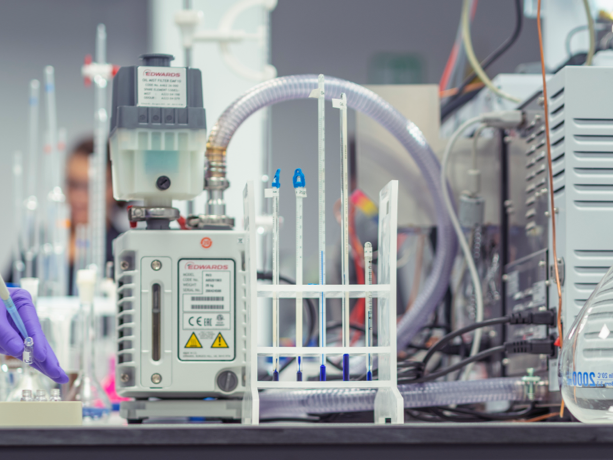Thermoset vs Thermoplastic: What’s the Difference?

Plastics are ubiquitous; used in everything from aerospace engineering and manufacturing, to children’s toys and tupperware. But, they aren’t all made equally. Different plastics have their own unique properties that will affect their suitability for various applications; which means it’s essential to know just what you’re using and how.
In this guide, we will explore the two primary categories, namely thermoset vs thermoplastics, and their key differences. Keep reading to learn more…
What are thermoset plastics?
As the name suggests, thermoset plastics harden (or set) once heated or upon the addition of a chemical agent. They’re usually liquid at room temperature, and solidify into their final form after curing.
The key thing to know about thermoset plastics is that once they’re moulded, that’s it. They will retain their shape, and cannot be melted down and reformed. This is because during the curing and setting process, these plastics form unbreakable chemical bonds between the polymer chains on a molecular level. These bonds are referred to as crosslinks.
Crosslinking drastically changes the mechanical properties of a material; in this case, giving the plastics their rigidity, durability, and increased structural integrity.
Advantages and disadvantages
This distinction, where thermosets do not re-melt into liquid form, offers a selection of advantages and disadvantages.
Some of the primary advantages to thermoset plastics are:
- Improved structural integrity: thermosets are hard and sturdy, and can be used in structural applications where suitable.
- Low thermal conductivity: this means thermoplastics are useful for insulating electronics and improving energy efficiency.
- High strength-to-weight ratio: this is important where you need strong but more lightweight components, and is why some thermosets are used in place of metal to reduce overall weight.
- Increased heat resistance: thermosets can withstand high temperatures without melting back into liquid form.
Thermoset plastics also have excellent corrosion and water resistance, are capable of being moulded into a wide range of shapes and product designs, and can often be cheaper to make than metal or thermoplastic components.
However, there are some disadvantages to the inherent finality of the thermoset form.
- Cannot be remoulded or reshaped: the irreversible crosslinks of thermoset plastics mean they cannot be remoulded or reshaped once cured.
- Non-recyclable: you cannot recycle thermoset plastics at the end of their lifespan, which means they’re less environmentally friendly and ecologically unsustainable.
Applications and examples of thermosets
Thermoset plastics are incredibly valuable in areas where increased heat resistance and exceptional durability can make a big difference. They’re also useful where metal components would be too heavy or expensive, and offer an enviable consistency during manufacture compared to other materials.
This is essential for a range of industries, including the aerospace, electrical, and energy industries, to name a few. Of course, different thermosets will be more or less useful in certain applications. For example:
Thermoset name | Properties | Primary uses |
Epoxy resin | Low shrinkage, excellent electrical insulation, adhesive properties, high tensile, compressive, and impact strength, brittle unless treated. | Construction adhesives, electrical encapsulation and insulation, waterproofing marine vessels. |
Melamine formaldehyde | Hard, durable, excellent fire and heat resistance, scratch resistance, chemically stable. | Decorative laminates, adhesives, industrial coatings, kitchenware. |
Polyester resin | High thermal stability, low shrinkage, relatively low cost, good chemical resistance, water resistance. | Fibreglass reinforced plastics (FRP), boat hulls and car bodies, roofing panels and piping, consumer products. |
Urea formaldehyde | High tensile strength, good heat and chemical resistance, stiff, brittle. | Wood adhesives (particleboard, MDF), electrical casing and fittings, slow-release fertiliser. |
What are thermoplastics?
At the opposite of the spectrum, thermoplastics are solid at room temperature and soften when heated. During product manufacture, these plastics are heated until they become liquid, and can be poured into a mould to solidify in the chosen shape. As this doesn’t involve any chemical agents, unlike thermosets, thermoplastics can be reused, reshaped, and recycled over and over without compromising the quality and properties of the base material.
Advantages and disadvantages
Like thermosets, the unique properties of thermoplastics means that there are advantages and disadvantages to using this material for product manufacture.
Some advantages include:
- Can be recycled and reused: thermoplastics are a more sustainable option, as they can be recycled over and over without compromising the material.
- High impact resistance: thermoplastics can withstand sudden impacts without deforming, which means they are durable, strong, and cost-effective when used in the right applications.
- Electrical resistance: this means they’re useful for insulating electrical components.
- Corrosion and chemical resistant: thermoplastics are resistant to degradation under chemical agents and corrosion, which extends their lifespan and the range of applications they can be used for.
- Aesthetically appealing: thermoplastics can be finished to a high standard, and resist chipping, which is valuable for visual and decorative applications.
Thermoplastics are also lightweight and robust, which is important for lots of industrial applications.
However, there are some disadvantages you should be aware of, such as:
- Poor performance at high heat: thermoplastics soften at high temperatures, so they shouldn’t be used where heat resistance is an essential consideration.
- Cost: thermoplastics are typically more expensive than thermosetting options.
Applications and examples of thermoplastics
With all these factors in mind, it’s essential that thermoplastics are used in the right way. There are a range of industries that can benefit from thermoplastics, such as; consumer products, packaging and manufacturing, electrical components, adhesive production, and many more.
Below, we’ve picked out some of the key thermoplastics used within different industries…
Thermoplastic name | Properties | Primary uses |
Polyamide (aka Nylon) | High impact resistance, abrasion resistance, high tensile strength, stiff, easy to process, good electrical insulation. | Synthetic fabrics and textiles, engineering plastics, coatings, packaging, automotive parts. |
Polymethyl methacrylate (Acrylic) | High transparency, UV and weathering resistance, good surface hardness, fair thermal stability. | Glass substitute components, medical devices and prosthetics, cladding panels, electronics. |
Polypropylene | Lightweight, can be sterilised, chemically resistant, durable, low moisture absorption, excellent electrical insulation. | Consumer goods, packaging, automotive parts, textiles, medical devices, electrical components. |
Polystyrene | Lightweight, chemically resistant, low moisture absorption, low thermal conductivity, fragile, flammable. | Packaging, consumer goods, insulating foam, medical equipment, home appliances, electronics. |
Low density polythene (LDPE) | Flexible, good moisture resistance, good impact resistance, low strength, expands and contracts with temperature fluctuations. | Plastic bags, packaging and containers, electrical cable insulation, agricultural equipment, toys. |
High density polythene (HDPE) | High tensile strength, wear resistance, good impact strength (even at low temperatures), easy to process, high electrical resistance, good chemical resistance. | Engineering components, recreational equipment, packaging, construction, marine and automotive components. |
Additionally, as we said previously, thermoplastics are a more sustainable option. This is increasingly becoming an essential consideration for product manufacturing, to ensure that products are more environmentally friendly.
What are the key differences between thermosets and thermoplastics?
No two materials are exactly the same, even when they’re part of the same overarching category. This is evident from the information above, where certain thermoplastics or thermosets behave differently to others in their group.
However, there are some overarching characteristics that can help you tell the difference between the two. At a glance, these include:
Quality | Thermosets | Thermoplastics |
State at room temperature | Liquid | Solid |
Recyclable | No | Yes |
High thermal resistance | Yes | No |
Electrical insulation | Yes | Yes |
Excellent impact resistance | No | Yes |
High dimensional stability | Yes | No |
High mechanical strength | Yes | No |
Good thermal conductivity | No | Yes |
Why is it important to know the difference between thermosets and thermoplastics?
It may be a very basic principle, but to get the best results you should always use the right material for specific applications. Factors like risk of abrasion, exposure to adverse conditions, potential for impact or damage, and so many more will affect how well a plastic can perform.
With thermosets and thermoplastics, this distinction is particularly important for heat-related applications. When one material has a high thermal tolerance, and another will melt in high temperatures, choosing the appropriate material is a matter of safety, longevity, and practicality.
The Lab: home of forensic investigations
If you’re ever in doubt, materials testing is ideal to ensure your chosen material is up to the task you require of it. Here at The Lab, we have an exceptional range of materials testing services to provide you with the answers you need.
From material identification and hardness testing, to coatings analyses, we can help you understand how a chosen material will behave; or identify faults and failures after the fact.
For more information, contact our team today for an obligation-free consultation.
Discover our materials testing services today
For more of the latest news, information, and industry insights, explore The Lab’s News and Knowledge Hub…
Shipbuilding Industry Introduces Humanoid Welding Robots To Workforce | What Metals Are Non-Ferrous? | Breakthrough Norbornene-Based Fluorinated Copolymers Rewrite Antifouling Technology
- Date
- 10/09/2025
